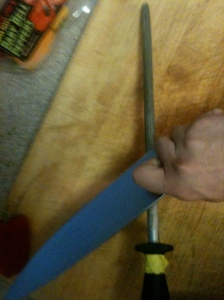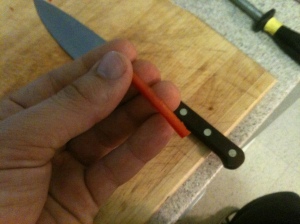On Mondays I like to return to the basics. I begin my series on basic skills with knife skills because a good chef is only a good chef if he or she has mastered and unfailingly practices the fundamental cuts. Mastery of the fundamentals takes time and dedication, but when commitment to them becomes habit they prove highly efficient and liberate the cook from dependence upon gadgets and food processors. I can remember with a clarity that still makes the hairs on the back of my neck stand up the overwhelming air of anxiety and focus paid by myself and my classmates in the first days at Le Cordon Bleu as we were charged to produce the classic cuts. We were graded strictly on a pass/fail basis and could not progress to sauces until we had passed this practical exam. A nick on the surface of a cut vegetable or a fraction of an inch short of specification and your entire board would be dumped into the bin relegated to the stock pot and you would have to start all of your cuts again. This degree of accuracy and precision serves as the foundation on which a good chef builds a repertoire of techniques, but without the solid foundation of the knife skills a chef will remain forever an amateur. I will make posts breaking down the process for all of these cuts over the course of the next several Mondays but for today we will start with two of the easiest: the Julienne and the Brunoise.
Getting Started
All that is needed is a standard 10 to 12-inch French knife, a cutting board stabilized on your counter by placing a damp washcloth under it, and a steel to true your blade.

Begin by truing the blade of your knife. When you use a knife steel you are NOT sharpening the blade, you are truing it by removing the small imperfections along the edge...its more of a cleaning. Sharpening is only done when you use a stone and for the good health of your knives sharpening is done on about a monthly or an as-needed basis. Truing should be done before working by running the blade along the steel slowly, precisely at a 10-12 degree angle. Like so.

Go back and forth, turning the knife over so each side of the blade is trued. At maximum you should run the steel over the edge of your knife about 5 times per side or 10 times total.
Cutting a Julienne
A Julienne is a cut used primarily for vegetables in which the product being cut is fabricated into pieces 1/8 inch by 1/8 inch by 2 to 21/2 inches…perfectly bite sized. The Julienne is called for in a variety of dishes, especially salads and stir-frys.

Prepare the pepper for julienning by cutting off the stem and tip so that the length of the remaining product is between 2 and 2 1/2 inches.

Completely remove the pithy interior and seeds. Discard the pithy interior and seeds but reserve the trimmed edible parts of the pepper. The edible trim is the perfect base for vegetable stock, which I will demonstrate in a later post.

Turn the pepper flesh skin side down and trim any remaining pith so that the depth of the material is 1/8 inch thick.

Turn the 2 1/2-inch long by 1/8-inch deep pieces of pepper over so that the skin is up and trim so all corners are 90-degrees, like so.

Secure the edge of the blade so that the knife cuts 1/8-inch strips out of the 2 1/2-inch long by 1/8-inch deep pepper pieces. This is achieved by folding fingertips away from the blade and carefully cutting with the knife face resting against the space on your fingers between the knuckle and the first bend in the fingers. Cut all of the 2 1/2-inch long by 1/8-inch pieces into 2 1/2-inch by 1/8 inch by 1/8 inch Juliennes.
Cutting a Brunoise
A Brunoise is a cut that is a cube 1/8-inch by 1/8-inch by 1/8-inch. It is called for in many recipes and works well in salads, omelets, etcetera. When you have additional Juliennes they can easily be turned into a Brunoise by cutting the 2 1/2-inch by 1/8-inch by 1/8-inch strips down into 1/8-inch by 1/8-inch by 1/8-inch cubes. When you just need a brunoise fabricate the vegetable flesh into 90-degree corner by 90-degree corner rectangles of any size, trim them to 1/8-inch in depth as done for the Julienne, cut them into 1/8-inch by 1/8-inch strips as with the Julienne, then proceed with producing your Brunoise. Since we have Juliennes I’ll be cutting them into Brunoise.






